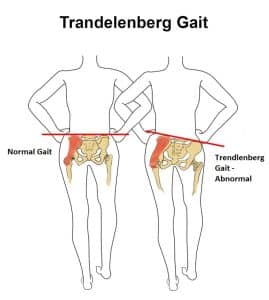Definition
The Trendelenburg test is a physical examination procedure used to measure the strength and function of the hip abductor muscles. It is named after the late-nineteenth-century German physician Friedrich Trendelenburg, who first described the test.
Purpose of the Trendelenburg Test
The Trendelenburg test is primarily used to assess gluteus medius muscle strength, which is responsible for pelvic stability during walking and other weight-bearing activities. Weakness or dysfunction of this muscle can result in the Trendelenburg gait, which is characterized by the pelvis dropping on the side opposite the afflicted muscle. The Trendelenburg test can also be used to evaluate the hip joint function and detect abnormalities such as hip dysplasia, arthritis, or dislocation.
Benefits and Advantages of the Trendelenburg Test
The Trendelenburg test is a simple and non-invasive way to assess hip muscle strength and function. It can provide valuable information for treatment planning and rehabilitation, as well as help prevent future injuries.
The Procedure of the Trendelenburg Test
The Trendelenburg test is a simple physical examination that can be performed in a clinical setting. Here are the steps involved in performing the test:
- Ask the patient to stand upright with both feet shoulder-width apart and arms at the sides.
- Instruct the patient to lift one leg off the ground and hold it in a flexed position at the hip joint.
- Observe the position of the pelvis and the hip of the lifted leg.
- Repeat the test with the other leg.
Interpretation of the Trendelenburg Test
The interpretation of the Trendelenburg test is based on the position of the pelvis during the test, which can be used to assess the function of the hip joint and the strength of the gluteus medius muscle. The test can yield either a positive or negative result, which indicates different levels of function.
Positive Trendelenburg Test
A positive Trendelenburg test is defined as a drop in the pelvis on the side of the lifted leg. This indicates weakness or dysfunction of the gluteus medius muscle on the opposite side. A positive test can be caused by a variety of conditions, such as hip abductor muscle weakness, hip dysplasia, hip joint pathology, or neurological disorders. A positive Trendelenburg test may also result in a characteristic gait abnormality known as the Trendelenburg gait, in which the pelvis drops on the side opposite to the affected muscle.

Negative Trendelenburg Test
A negative Trendelenburg test indicates normal hip abductor muscle strength and function. This means that there is no drop in the pelvis on the side of the lifted leg, and the pelvis remains level during the test. A negative test is considered normal and does not suggest any significant pathology or dysfunction.
False-Positive and False-Negative Results
It is important to note that false-positive and false-negative results can occur with the Trendelenburg test. A false-positive result occurs when the test indicates weakness or dysfunction of the gluteus medius muscle, but there is actually no underlying pathology or dysfunction. This can be caused by compensatory mechanisms or incorrect execution of the test.
A false-negative result, on the other hand, occurs when the test indicates normal hip abductor muscle strength and function, but there is actually underlying pathology or dysfunction. This can be caused by compensatory mechanisms or inadequate activation of the gluteus medius muscle.
Limitations of the Trendelenburg Test
Although the Trendelenburg test is a useful screening tool, there are several limitations to be aware of. For example, it exclusively tests gluteus medius muscle strength and does not provide information on other muscles that may contribute to hip stability. Furthermore, it does not pinpoint the precise reason for muscular weakness or dysfunction, which may necessitate other diagnostic procedures such as imaging examinations or electromyography.
Potential Risks and Complications of the Trendelenburg Test
In rare cases, the Trendelenburg test can cause pain or discomfort in patients with pre-existing hip pathology. Additionally, patients with severe hip instability or muscle weakness may have difficulty performing the test, which can affect the accuracy of the results.
Variations and Modifications of the Trendelenburg Test
There are several variations and modifications of the Trendelenburg test that can be used to improve its accuracy or suitability for specific patient populations or conditions.
Alternative Methods of Performing the Trendelenburg Test
One alternative method of performing the Trendelenburg test is the Single-Leg Stance Test, which assesses similar muscle groups and functionality but with a different patient positioning. Another variation is the Trendelenburg Lurch test, which is a gait analysis test used to evaluate patients with gait abnormalities or muscle imbalances.
Special Considerations for Specific Populations or Conditions
For patients with severe hip instability or muscle weakness, a modified Trendelenburg test may be necessary to achieve accurate results. Additionally, in elderly or obese patients, the use of hinged joint stabilizers or assistive devices can be helpful in achieving proper patient positioning and improving test accuracy.
FAQ
What is the purpose of the Trendelenburg test?
The Trendelenburg test is used to evaluate the strength and function of the hip abductor muscles, specifically the gluteus medius, and minimus. The test can help healthcare professionals identify conditions such as hip osteoarthritis, sciatic nerve dysfunction, and muscular weakness or imbalance.
Is the Trendelenburg test painful?
No, the Trendelenburg test is generally not painful. However, patients may experience mild discomfort or fatigue during the test due to the effort required to stand on one leg.
Can anyone perform the Trendelenburg test?
No, the Trendelenburg test should only be performed by qualified healthcare professionals such as orthopedists, physical therapists, or neurologists who have been trained in the procedure and interpretation of results.
What are the risks of the Trendelenburg test?
The Trendelenburg test is generally considered safe, but there is a small risk of falls or other injuries, particularly in elderly or unsteady patients. Patients with severe hip or knee pain or instability should not undergo the test.
Latest Posts
- Tips for Getting Better Sleep with Anxiety in 2024

- Split Renal Test: The Best Way to Diagnose Dangerous Kidney Problems in 2024

- Revolutionizing Treatment-Resistant Schizophrenia Solutions: Unleashing Hope in 2024

- Demystifying Obsessive-Compulsive Disorder in 2024: Understanding OCD from the Inside Out

- Unmasking the Mind: Can the DAP Test Truly Decode Your Mind in 2023?

